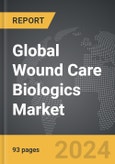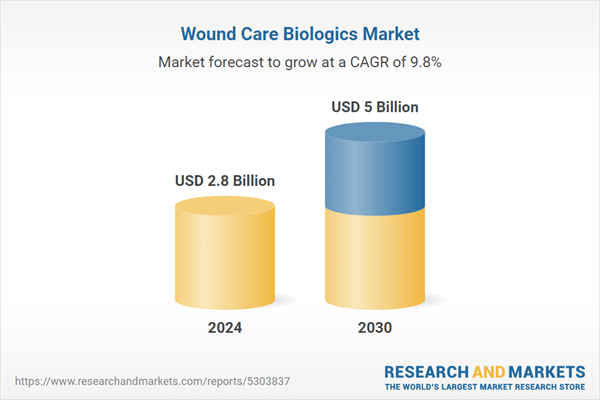The global market for Wound Care Biologics was valued at US$2.8 Billion in 2024 and is projected to reach US$5.0 Billion by 2030, growing at a CAGR of 9.8% from 2024 to 2030. This comprehensive report provides an in-depth analysis of market trends, drivers, and forecasts, helping you make informed business decisions. The report includes the most recent global tariff developments and how they impact the Wound Care Biologics market.
Skin substitutes play a crucial role in managing non-healing wounds, offered as either temporary or permanent solutions and are categorized into acellular and cellular products. The latter involves living cells integrated within a matrix, aiding in faster and more effective wound closure. Moreover, the application of exogenous growth factors such as recombinant human platelet-derived growth factor-BB (rhPDGF-BB) has become instrumental in stimulating repair processes, though their success largely depends on the wound bed's condition. Additionally, the development of bioartificial scaffolds that mimic the skin's extracellular matrix highlights the shift towards more sophisticated wound care approaches. These scaffolds, incorporating biological components such as collagen and hyaluronic acid, not only support but actively promote healing, distinguishing them from traditional wound dressings.Recent trends in the wound care biologics market reflect a growing focus on personalized medicine and cost-effective treatment options. There is a notable shift towards allogeneic therapies, where biologic materials are sourced from donors rather than from the patients themselves, which can reduce costs and simplify treatment protocols. Moreover, regulatory support for biologic-based therapies is expanding, with numerous products receiving fast-track designations and approvals from bodies such as the FDA.Global increase in the prevalence of diabetes and the corresponding rise in diabetic ulcers
continues to fuel the demand for effective wound healing solutions. As diabetic patients often experience reduced healing capabilities, biologics play a crucial role in managing chronic wounds and preventing complications. Advancements in biotechnology have enabled the development of more effective and efficient biologic treatments that can significantly reduce healing times and improve patient outcomes. These advancements include innovations in growth factor technology, genetically engineered skin substitutes, and cultured epithelial autografts. Additionally, the aging global population, which is more susceptible to chronic conditions that impair wound healing, further increases the demand for biologic treatments.
Segments: Product (Biologic Skin Substitutes, Topical Agents); Wound Type (Ulcers, Surgical & Traumatic Wounds, Burns); End-Use (Hospitals, ASCs, Burn Centers & Wound Clinics).
Geographic Regions/Countries: World; United States; Canada; Japan; China; Europe (France; Germany; Italy; United Kingdom; Spain; Russia; and Rest of Europe); Asia-Pacific (Australia; India; South Korea; and Rest of Asia-Pacific); Latin America (Argentina; Brazil; Mexico; and Rest of Latin America); Middle East (Iran; Israel; Saudi Arabia; United Arab Emirates; and Rest of Middle East); and Africa.
The analysts continuously track trade developments worldwide, drawing insights from leading global economists and over 200 industry and policy institutions, including think tanks, trade organizations, and national economic advisory bodies. This intelligence is integrated into forecasting models to provide timely, data-driven analysis of emerging risks and opportunities.
Global Wound Care Biologics Market - Key Trends and Drivers Summarized
In the evolving landscape of medical treatments, wound care biologics represent a significant advancement, introducing a blend of natural and synthetic biomaterials to enhance the healing process. Wound care biologics refer to the use of biologically derived materials, such as growth factors, skin substitutes, and tissue-based products, to facilitate the healing of wounds. These biologics are primarily used to treat complex wounds that do not heal easily through traditional methods, including diabetic ulcers, burns, and severe lacerations. By harnessing the natural healing capabilities of biological materials, wound care biologics promote tissue regeneration and accelerate the recovery process, making them an essential component of advanced wound management strategies. Wound healing is facilitated by a sophisticated interplay of cellular and extracellular components, growth factors, and matrix metalloproteinases, which are often compromised in chronic wounds. Wound care biotechnology aims to address these deficits by introducing biologically active treatments to the wound site. Among the most promising are cell-based therapies, which utilize the regenerative capabilities of stem cells such as keratinocytes, fibroblasts, and adipose-derived stromal cells. These are applied as either autologous or allogeneic grafts to enhance the wound bed's receptiveness to healing.Skin substitutes play a crucial role in managing non-healing wounds, offered as either temporary or permanent solutions and are categorized into acellular and cellular products. The latter involves living cells integrated within a matrix, aiding in faster and more effective wound closure. Moreover, the application of exogenous growth factors such as recombinant human platelet-derived growth factor-BB (rhPDGF-BB) has become instrumental in stimulating repair processes, though their success largely depends on the wound bed's condition. Additionally, the development of bioartificial scaffolds that mimic the skin's extracellular matrix highlights the shift towards more sophisticated wound care approaches. These scaffolds, incorporating biological components such as collagen and hyaluronic acid, not only support but actively promote healing, distinguishing them from traditional wound dressings.Recent trends in the wound care biologics market reflect a growing focus on personalized medicine and cost-effective treatment options. There is a notable shift towards allogeneic therapies, where biologic materials are sourced from donors rather than from the patients themselves, which can reduce costs and simplify treatment protocols. Moreover, regulatory support for biologic-based therapies is expanding, with numerous products receiving fast-track designations and approvals from bodies such as the FDA.Global increase in the prevalence of diabetes and the corresponding rise in diabetic ulcers
continues to fuel the demand for effective wound healing solutions. As diabetic patients often experience reduced healing capabilities, biologics play a crucial role in managing chronic wounds and preventing complications. Advancements in biotechnology have enabled the development of more effective and efficient biologic treatments that can significantly reduce healing times and improve patient outcomes. These advancements include innovations in growth factor technology, genetically engineered skin substitutes, and cultured epithelial autografts. Additionally, the aging global population, which is more susceptible to chronic conditions that impair wound healing, further increases the demand for biologic treatments.
Report Scope
The report analyzes the Wound Care Biologics market, presented in terms of units. The analysis covers the key segments and geographic regions outlined below.Segments: Product (Biologic Skin Substitutes, Topical Agents); Wound Type (Ulcers, Surgical & Traumatic Wounds, Burns); End-Use (Hospitals, ASCs, Burn Centers & Wound Clinics).
Geographic Regions/Countries: World; United States; Canada; Japan; China; Europe (France; Germany; Italy; United Kingdom; Spain; Russia; and Rest of Europe); Asia-Pacific (Australia; India; South Korea; and Rest of Asia-Pacific); Latin America (Argentina; Brazil; Mexico; and Rest of Latin America); Middle East (Iran; Israel; Saudi Arabia; United Arab Emirates; and Rest of Middle East); and Africa.
Key Insights:
- Market Growth: Understand the significant growth trajectory of the Biologic Skin Substitutes segment, which is expected to reach US$3.1 Billion by 2030 with a CAGR of a 10.4%. The Topical Agents segment is also set to grow at 8.9% CAGR over the analysis period.
- Regional Analysis: Gain insights into the U.S. market, valued at $729.2 Million in 2024, and China, forecasted to grow at an impressive 14.0% CAGR to reach $1.3 Billion by 2030. Discover growth trends in other key regions, including Japan, Canada, Germany, and the Asia-Pacific.
Why You Should Buy This Report:
- Detailed Market Analysis: Access a thorough analysis of the Global Wound Care Biologics Market, covering all major geographic regions and market segments.
- Competitive Insights: Get an overview of the competitive landscape, including the market presence of major players across different geographies.
- Future Trends and Drivers: Understand the key trends and drivers shaping the future of the Global Wound Care Biologics Market.
- Actionable Insights: Benefit from actionable insights that can help you identify new revenue opportunities and make strategic business decisions.
Key Questions Answered:
- How is the Global Wound Care Biologics Market expected to evolve by 2030?
- What are the main drivers and restraints affecting the market?
- Which market segments will grow the most over the forecast period?
- How will market shares for different regions and segments change by 2030?
- Who are the leading players in the market, and what are their prospects?
Report Features:
- Comprehensive Market Data: Independent analysis of annual sales and market forecasts in US$ Million from 2024 to 2030.
- In-Depth Regional Analysis: Detailed insights into key markets, including the U.S., China, Japan, Canada, Europe, Asia-Pacific, Latin America, Middle East, and Africa.
- Company Profiles: Coverage of players such as Acell, Anika Therapeutics, Integra Lifesciences, Kerecis, Marine Polymer Technologies and more.
- Complimentary Updates: Receive free report updates for one year to keep you informed of the latest market developments.
Some of the 42 companies featured in this Wound Care Biologics market report include:
- Acell
- Anika Therapeutics
- Integra Lifesciences
- Kerecis
- Marine Polymer Technologies
- Mimedx Group
- Mölnlycke Health Care AB (Investor AB)
- Organogenesis
- Osiris Therapeutics
- Smith & Nephew
Tariff Impact Analysis: Key Insights for 2025
Global tariff negotiations across 180+ countries are reshaping supply chains, costs, and competitiveness. This report reflects the latest developments as of April 2025 and incorporates forward-looking insights into the market outlook.The analysts continuously track trade developments worldwide, drawing insights from leading global economists and over 200 industry and policy institutions, including think tanks, trade organizations, and national economic advisory bodies. This intelligence is integrated into forecasting models to provide timely, data-driven analysis of emerging risks and opportunities.
What’s Included in This Edition:
- Tariff-adjusted market forecasts by region and segment
- Analysis of cost and supply chain implications by sourcing and trade exposure
- Strategic insights into geographic shifts
Buyers receive a free July 2025 update with:
- Finalized tariff impacts and new trade agreement effects
- Updated projections reflecting global sourcing and cost shifts
- Expanded country-specific coverage across the industry
Table of Contents
I. METHODOLOGYII. EXECUTIVE SUMMARY2. FOCUS ON SELECT PLAYERSIII. MARKET ANALYSISCANADAITALYSPAINRUSSIAREST OF EUROPESOUTH KOREAREST OF ASIA-PACIFICARGENTINABRAZILMEXICOREST OF LATIN AMERICAIRANISRAELSAUDI ARABIAUNITED ARAB EMIRATESREST OF MIDDLE EASTIV. COMPETITION
1. MARKET OVERVIEW
3. MARKET TRENDS & DRIVERS
4. GLOBAL MARKET PERSPECTIVE
UNITED STATES
JAPAN
CHINA
EUROPE
FRANCE
GERMANY
UNITED KINGDOM
ASIA-PACIFIC
AUSTRALIA
INDIA
LATIN AMERICA
MIDDLE EAST
AFRICA
Companies Mentioned (Partial List)
A selection of companies mentioned in this report includes, but is not limited to:
- Acell
- Anika Therapeutics
- Integra Lifesciences
- Kerecis
- Marine Polymer Technologies
- Mimedx Group
- Mölnlycke Health Care AB (Investor AB)
- Organogenesis
- Osiris Therapeutics
- Smith & Nephew
Table Information
| Report Attribute | Details |
|---|---|
| No. of Pages | 93 |
| Published | April 2025 |
| Forecast Period | 2024 - 2030 |
| Estimated Market Value ( USD | $ 2.8 Billion |
| Forecasted Market Value ( USD | $ 5 Billion |
| Compound Annual Growth Rate | 9.8% |
| Regions Covered | Global |









